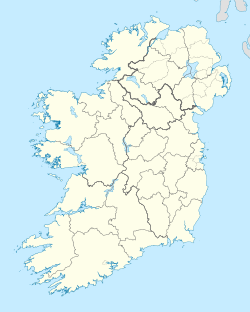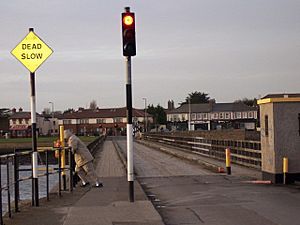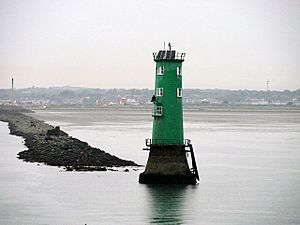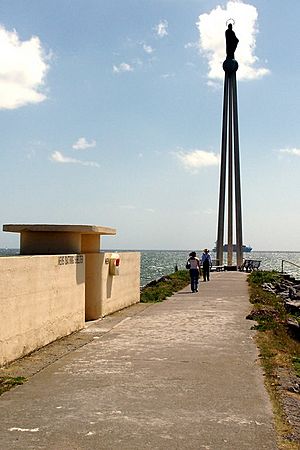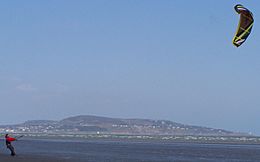Bull Island facts for kids
|
Native name:
Oileán an Tairbh
|
|
|---|---|
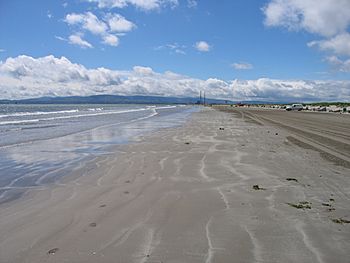
Dollymount Strand looking towards Dublin City
|
|
| Geography | |
| Location | Irish Sea |
| Coordinates | 53°22′01″N 6°08′55″W / 53.367065°N 6.148560°W |
| Length | 5 km (3.1 mi) |
| Width | 0.8 km (0.5 mi) |
| Coastline | 11 km (6.8 mi) |
| Administration | |
| Province | Leinster |
| County | Dublin |
| Local authority | Dublin City Council |
| Official name: North Bull Island | |
| Designated: | 6 September 1988 |
| Reference #: | 406 |
Bull Island, also known as North Bull Island, is a special island in Dublin Bay, Ireland. It's about 5 kilometers (3 miles) long and 800 meters (half a mile) wide. The island has a beautiful sandy beach called Dollymount Strand.
What makes Bull Island unique is that it formed by accident! It grew over time because of human efforts to improve Dublin Port. Today, it's mostly owned and managed by Dublin City Council. You can reach the island by a wooden bridge from Clontarf or a causeway from Raheny. It's a car-free zone, meaning you can't drive on most of it.
Bull Island is super important for nature. It's a National Bird Sanctuary, a special nature reserve, and even a biosphere reserve recognized by UNESCO. This means it's a safe home for many plants and animals, especially birds.
Contents
How Did Bull Island Form?
Solving a Silting Problem
For a long time, Dublin Bay had a big problem: too much sand and mud built up at the mouth of the River Liffey. This made it hard for ships to get into Dublin Port. To fix this, people started building big walls.
In 1715, they began building the Great South Wall. It was finished in 1730. But storms damaged it, and the silting problem continued. So, in 1761, they started building a strong stone pier from the Poolbeg Lighthouse. This huge wall was finished in 1795.
Even with the South Wall, the problem wasn't fully solved. So, experts suggested building a North Bull Wall too. Captain William Bligh, famous from the Mutiny on the Bounty, surveyed Dublin Bay in 1801. He saw the potential of the North Bull sandbank. The idea was that these walls would help the tides naturally clear the sand.
Building the North Bull Wall
To build the North Bull Wall, a wooden bridge, the first Bull Bridge, was put up in 1819. The stone wall itself was started in 1820 and finished in 1825. It cost a lot of money back then – about £95,000!
After the walls were built, the tides worked their magic. Over 48 years, the entrance to the Liffey River became much deeper. The sand and mud that used to block the river were now carried away and deposited on the North Bull sandbank. This is how Bull Island started to grow!
The Island Grows and Becomes Popular
As the island grew, people began to visit the new beach. More and more visitors came when horse trams started going to Clontarf in 1873. A full tram line to Howth opened in 1900, with stops near Dollymount. A Coast Guard station was also built near the Bull Wall.
The island kept getting bigger, stretching towards Howth Head. People enjoyed picnics and swimming. It was even used for shooting practice! In 1880, a big rifle match between Ireland and the USA was held there, with thousands of people watching.
In 1889, the Royal Dublin Golf Club got permission to build a golf course on the island. Around the early 1900s, a walking path was made from Raheny to the island. This path was useful for people wanting to relax or find things washed up on the beach.
Between 1906 and 1907, a new wooden Bull Bridge was built. This is the bridge that is still used today! In 1912, the Dollymount Sea Scouts started using part of the old Coast Guard station as their meeting place. They are still active there today!

World War I and New Golf Clubs
During World War I, the British Army took over the entire island on September 5, 1914. They used it for military training, including a firing range and practicing trench warfare. The Royal Dublin Golf Club's clubhouse was used by officers. The island's environment was damaged, especially by the trench practice.
After the war, in 1921, a new golf club called St. Anne's was formed at the Raheny end of the island. It started as a nine-hole course.
Plans for the Island
In 1931, there were plans to develop the island and the water around it. One idea, called the "Blue Lagoon Scheme," would have created a high water level behind the island. There were even plans for housing or tourist facilities. Other ideas included turning much of the island into a theme park!
However, in 1931, people like the Jesuit bird expert Fr. Patrick G. Kennedy SJ convinced Dublin City Council to ask the government to make Bull Island a sanctuary. This was a big step in protecting its nature.
Where is Bull Island?
The island is connected to the mainland by two ways. There's the Bull Bridge, a one-lane wooden road bridge at the southern end (near Clontarf/Dollymount). There's also a wide causeway at Raheny, about halfway along the island. The island is part of the Raheny and Clontarf areas.
Most of North Bull Island belongs to Dublin City Council. They bought it from various owners. The only parts not owned by the Council are the Royal Dublin Golf Club links. St. Anne's Golf Club rents its land from the Council. The island is the largest park owned by the city.
Only a few people live on the island, in houses near the wooden bridge. Besides the golf clubhouses, there's a newly rebuilt Sea Scout den and a small cafe. At the end of the North Bull Wall, you'll find the Star of the Sea (Realt na Mara) statue. It was paid for by Dublin Port workers and sailors.
Wildlife on Bull Island
Bull Island is a fantastic place for wildlife!
Birds
Many different birds visit Bull Island. Some stay for the winter, while others just pass through in spring and autumn. You can see wading birds like Eurasian curlews, Eurasian oystercatchers, and redshanks. Other birds include shelducks, teal, pale-bellied brent geese, and various types of gulls. Keep an eye out for grey plovers, bar-tailed godwits, northern shovellers, little egrets, reed buntings, and little terns.
Mammals
The island is home to several mammal species. You might spot pygmy shrews, brown rats, red foxes, field mouses, hedgehogs, and European rabbits. Sadly, the Irish hare used to live here but disappeared between 2016 and 2019. However, stoats have been seen on the island since the mid-2010s.
Hares were once very common, but their numbers dropped. This was partly because of the causeway being built, which caused disturbance. Studies showed that people and dogs disturbing them, especially during breeding, led to their decline. Hares are more vulnerable because they don't hide in burrows like rabbits.
Rabbits were also much more common in the past. But in the early 1990s, diseases like myxomatosis and rabbit haemorrhagic disease caused a big drop in their population.
In the waters around the island, you can often see common seals and grey seals resting on the sand at low tide. The island is a breeding spot for them. Sometimes, you might even spot Harbour porpoises out in the bay.
Reptiles and Amphibians
The island has a small number of common lizards. You can also find a healthy population of common frogs on the island.
Insects and Other Small Creatures
Bull Island is also home to many invertebrates. These include ground beetles, different types of butterflies and moths, aphids, wasps, snails, spiders, harvestmen, earthworms, and woodlice.
Plants on Bull Island
Many different plants grow on Bull Island. You can find beautiful orchids like the bee orchid, pyramidal orchid, Marsh Helleborine, and common spotted orchids. The most important plant is marram grass. This grass is super important because its roots help hold the sand dunes together, stopping them from blowing away.
Why is Bull Island So Important?
North Bull Island has more special protections than almost any other place in Ireland. Its importance for nature has been recognized for a long time.
- In 1914, it was listed as a Rothschild Reserve.
- In 1931, it became the first National Bird Sanctuary.
- Since 1981, UNESCO has named it a biosphere reserve. It's the only biosphere reserve completely within a capital city in the world!
- In 1988, it became a National Nature Reserve.
- It's also part of the Natura 2000 Network, which means it's important for the whole European Union. It's a Special Protection Area for birds and a Special Area of Conservation for habitats.
- Since 1995, it's been a National Special Amenity Area. This means its amazing beauty and nature are officially protected.
Interpretive Centre
There's an Interpretive Centre at the end of the causeway. It has displays and information about the plants and animals that live on the island. You'll also find information signs along the causeway and near the beach. The Centre opened in 1986 and is a great place for schools and groups to learn about the island.
Fun Things to Do on Bull Island
Walking
Dollymount Strand, the 5-kilometer (3-mile) beach, is a very popular place for walking and relaxing. Many people walk their dogs here, but they should be kept under control. This is important because the island is a National Nature Reserve, and there are concerns about dogs disturbing rabbits and hares. You can even walk a big loop that includes the beach and St. Anne's Park.
Driving on the Beach
For many years, people learned to drive on the firm, flat sand of Dollymount Strand at low tide. There are even very low speed limits posted on the beach! However, since 2016, car access to the beach has been limited to a small area near the Bull Bridge.
Swimming
The beach has always been a popular spot for swimming. In the 1980s, pollution made the water less clean. But thanks to efforts to improve water quality in the 1990s, things got much better. For several years, the beach even earned Blue Flag status, which means it met high standards for water quality and safety. While it hasn't received the Blue Flag recently, the beach is still kept to high standards.
Kite-surfing
In recent years, Bull Island has become a favorite spot for kite-surfers. There's a special area near the Bull Wall for launching kites. The shallow water and long, straight beach make it a safe place for kite-surfing, especially for beginners.
Golf
The island has two golf courses. One belongs to the famous Royal Dublin Golf Club. The other is owned by Dublin City Council and operated by St. Anne's Golf Club. Both clubs have clubhouses where you can eat.
Bull Island in Movies
Bull Island has been used as a filming location for many movies set in Dublin. Some famous films include Neil Jordan's Michael Collins, Stephen Frears's The Van, Brendan O'Carroll's Mrs. Brown's Boys D'Movie, and John Carney's Oscar-winning movie Once.
Images for kids
-
A kite enthusiast on Bull Island with Howth and the Sutton Martello tower in the background.
See also
 In Spanish: Isla Bull para niños
In Spanish: Isla Bull para niños


